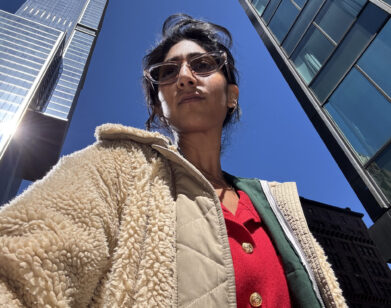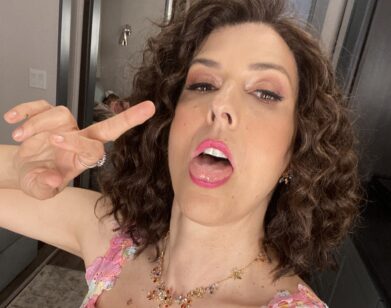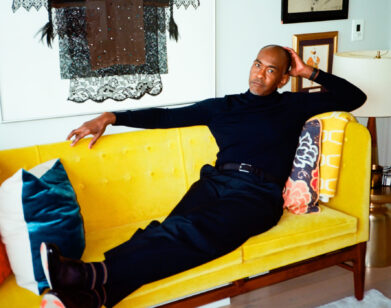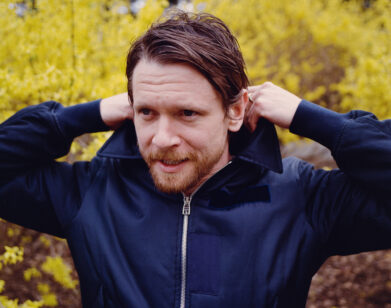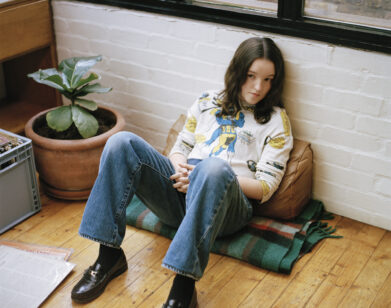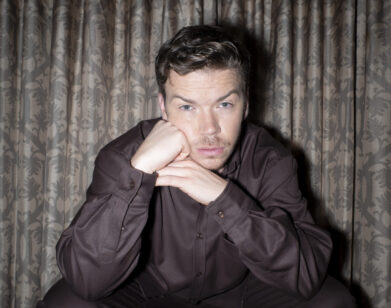When Troma Met MoMA
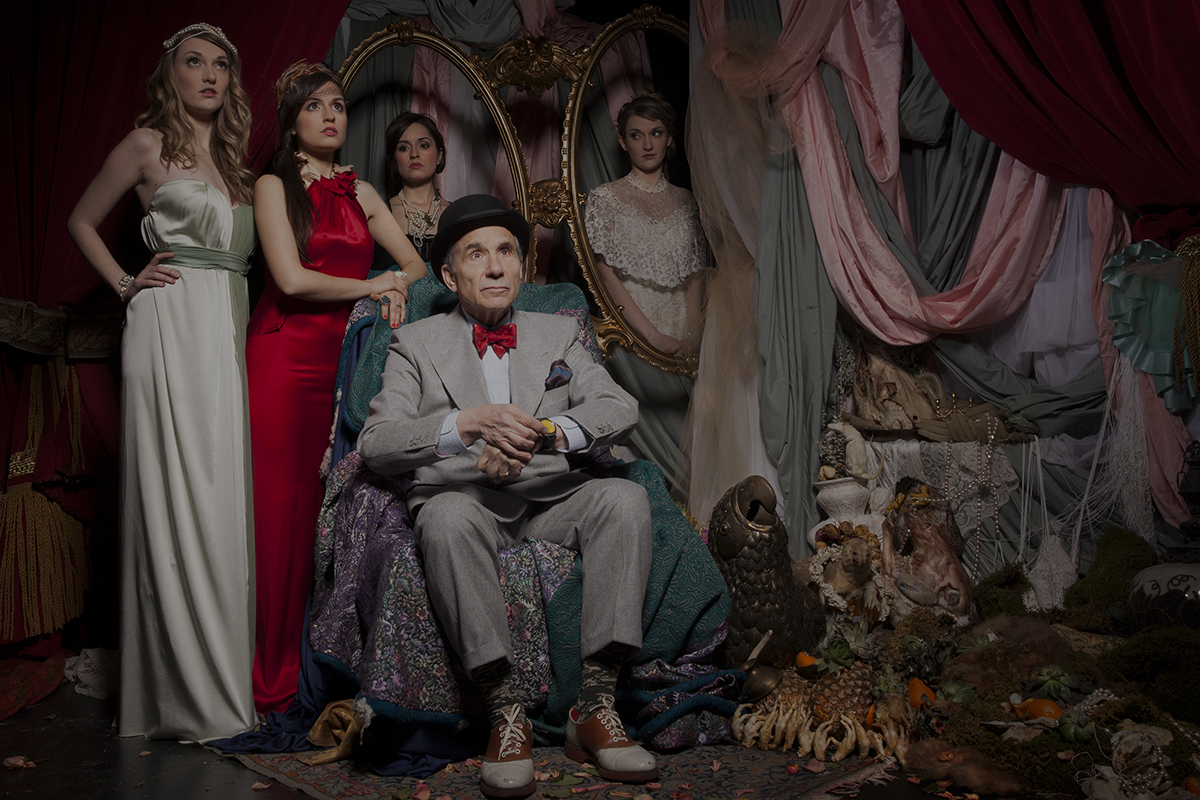
ABOVE, L-R: RETURN TO NUKE EM HIGH: VOL. 1’s STARS CATHERINE CORCORAN, ASTA PAREDES, AND DIRECTOR LLOYD KAUFMAN. PHOTO BY VENTIKO, TAKEN AT LA LUZ IN BROOKLYN.
The latest film from Troma Entertainment, Return To Nuke Em High: Vol. 1, is not exactly a sequel to 1986’s Class of Nuke Em High—it’s more of a revamped, rebooted reimagining for a new generation. It is embarrassingly clear at this point that modern Hollywood reproductions of successful films of the past are usually nothing more than a shameless cash grab. What sets Return To Nuke Em High: Vol. 1 apart from these other unwarranted and ultimately forgettable remakes is the fact that it is perhaps the best parody of this unfortunate plague on the current film landscape to date. And like the film’s director and longtime face of Troma, Lloyd Kaufman, it doesn’t rest on its laurels—it makes fun of them.
Of course, satire is nothing new for Troma; 2014 marks the 40th anniversary of the independent film studio, which Kaufman co-founded with Michael Herz in 1974. On Thursday, Return To Nuke Em High: Vol. 1 will screen as part of The Contenders 2013, an annual review of the most innovative and influential films of the last year curated and hosted by The Museum of Modern Art. Highlights include modern greats such as 12 Years a Slave, Gravity, Inside Llewyn Davis, and The Palme d’Or winning indie darling Blue Is the Warmest Color, which, like Return to Nuke Em High Vol. 1 (Blue’s bizarre younger sister), has a compelling love story between two rebellious young women at its core.
Much of Return’s success can be attributed to the film’s loyal and talented young leads, Catherine Corcoran and Asta Paredes, whose on- and offscreen chemistry, and overall tenacity to see their work taken seriously, has carried their little film from the Cannes Film Festival, to MoMA, and on to a limited theatrical release at The Village East Cinema. Kaufman, who has worked with a long line of promising young talent over the last four decades (among them Billy Bob Thornton, Kevin Costner, Samuel L. Jackson, Marisa Tomei, Vincent D’Onofrio, and Trey Parker and Matt Stone) goes out of his way to cite Corcoran and Paredes as the finest young actors he’s had the pleasure to direct.
Interview caught up with Kaufman, Corcoran, and Paredes at La Luz, a multi-media event and theatre space in Brooklyn, to discuss Troma’s unlikely turn at MoMA, the state of independent film, and the undeniable guerilla marketing power of a faux gay wedding.
KURT MCVEY: I first saw Return To Nuke Em High: Vol. 1 at the New York City Horror Film Festival, in Tribeca back in October, and I have to say, I had a great time. Critics, when reviewing certain films will often say, “It was a rollicking good time” or something of that nature, but there is still this very clear divide between the audience and the film itself. With this movie it was a completely different experience. People were cheering, yelling, laughing, jumping out of their seats, and just contributing wholeheartedly to the onscreen festivities. It was amazing. And I usually become irate if people even cough during a movie.
LLOYD KAUFMAN: Roger Ebert liked our low-budget movies because they’re made for communal viewing. The fact that this movie is getting a theatrical distribution in this day and age is miraculous. We make these movies for the shared theatrical experience, even though our biggest audience is the home viewing market. We hope everyone, especially critics and people not necessarily familiar with Troma, has an experience like you had.
MCVEY: Recently, critics have been bashing big-budget 3D event films with attached premium ticket prices as soulless spectacle in the name of getting people in the seats, often dismissing said films as “theme park cinema.” In response to this, do you think there’s a market out there for the bygone low-budget midnight movies and drive-in fare that encourages the audience to participate and treat the experience like a party?
KAUFMAN: I know this is Warhol’s magazine, so I should tell you that when I was at Yale, I hung out at The Factory, I was on the fringes, I was there, I saw stuff going on. I was a big fan of Andy’s movies. I was also a big fan of Bertolt Brecht, and breaking the fourth wall and all that stuff. Those movies were a total party. What makes a Troma film fun is its self-awareness. The audience is in on the joke. I’m not sure we’re in a place to change the industry, but the world seems to be responding to this film in new and interesting ways.
MCVEY: Has an audience member ever added anything memorable to the film experience?
ASTA PAREDES: At the Chicago premiere, there was this guy in the front row who can only be described as a super-fan—I’m pretty sure his name was Ulysses—and he was doing play-by-play throughout the whole thing like it was a sporting event. [laughs] Catie and I were sitting behind him cracking up the whole time.
CATHERINE CORCORAN: It got a little weird during our love scene. [Laughs] I remember Ulysses being devastated when the movie ended. We had to console him. I’ve stopped watching the movie altogether, and started watching and listening to the audience.
PAREDES: Ulysses and I are Instagram friends now.
MCVEY: Your film premiered at the Cannes Film Festival in May alongside Palme d’Or winner Blue Is The Warmest Color. Both films are also official selections in the MoMA Contenders series. How aware are you of the similarities between the two films and their parallel trajectories?
PAREDES: Our films do co-exist, and they have definitely affected each other. Both films premiered at Cannes on the eve of the French legalization of gay marriage, but I think it’s fair to say that we were a little more aggressive in tackling the issue on the streets in our trademark Troma brand of hands-on guerilla demonstrations.
CORCORAN: We warned the festival ahead of time that we were looking to stage a faux gay wedding between Asta and I on the street, to show the people of France not only that our relationship in the film isn’t about exploitation, but that it’s about this idea of self-discovery that all human beings go through and their right to do so on their own terms.
PAREDES: We even gave out wedding invitations to the French police. [laughs]
CORCORAN: At first they asked us if we had a permit. That’s when we had to tell them it wasn’t real. The French police were initially on board, but we’re pretty sure Cannes got nervous and intervened. Two unidentified festival producers approached us just before the “wedding” and told us that we couldn’t go through with it and that if we did, they would have the police arrest us.
PAREDES: Luckily, at lunch Catie and I had discussed dramatically reenacting the Paul Newman-Joanne Woodward 2013 Cannes poster if something like this happened; our own little “love-in” if you will. So at the press conference, right on the Croisette, we just dropped to the ground and kissed and the cameras went crazy.
CORCORAN: Within hours, the photo was everywhere. It quickly went viral, and Le Figaro, a French newspaper, called us the first gay marriage in France. So the festival changed their mind. I think they were under a lot of pressure. They agreed to let us stage the marriage in The Marché du Film for the press but not the public, as long as we let people know it wasn’t real.
PAREDES: They literally were afraid that we might start a riot—their words, not ours. In fact, there were anti-gay protestors outside our hotel room at one point. We thought they were fans at first.
MCVEY: Were you about to run outside and sign autographs?
CORCORAN: Yes, until we saw the picket signs. We did invite them to the screening, but they declined. [laughs]
PAREDES: We would never take credit for Blue Is The Warmest Color’s success at Cannes, but we’d be lying to ourselves and everyone else if we didn’t take responsibility for stirring up a climate that built awareness and perhaps put some pressure on the festival to respond accordingly and maybe even, dare I say, save face.
KAUFMAN: Even before Troma started making films in the ’70s, we were staging street performances and protests like this.
MCVEY: Lloyd, when you hired Catie and Asta for this film, did you know exactly how hands-on they would be with the politics around the film, let alone how powerful their on screen chemistry would be?
KAUFMAN: Well, it was a fairly long audition period. I believe it was nine auditions each. They were together for the entire process; almost three months of pre-production and a lot of rehearsal. But that was only the beginning. They created every facet of their characters; wardrobe, makeup, everything. I have to give credit to Chelsea Holland, our casting director, for picking up on their chemistry almost immediately.
CORCORAN: Chelsea really helped us find the characters, but Lloyd is truly amazing in that he creates an atmosphere that allows for ongoing collaboration.
PAREDES: This was film school, definitely.
MCVEY: Has Lloyd ever lost his cool on set?
PAREDES: Oh yeah. Don’t mess up. Make sure your effects work. Don’t be an idiot.
CORCORAN: Lloyd will happily tell you if you’re being an idiot.
KAUFMAN: I can get a little emotional.
MCVEY: Let’s talk about MoMA. Was there a campaign at all to be accepted into The Contenders series?
KAUFMAN: People always ask me, “How did you sneak into MoMA? Did you bribe someone? Is someone being held hostage somewhere?” It was the film, I promise you! Also, MoMA has a young Chief Curator of Film, Rajendra Roy, who from what I understand genuinely enjoyed the film. That being said, their previous curator wouldn’t give us the time of day. He couldn’t fathom that there was anything meritorious to be found in our little independent films.
CORCORAN: People want to say, “It’s just a Troma movie.” But I can’t express enough how proud we all are in terms of what this film has and will continue to accomplish, not just at festivals, or how it has transcends this artistically oppressive climate of political correctness, but that it’s really and simply a great movie.
PAREDES: It’s also dangerous allegory. It takes place in a high school, which is really an Orwellian microcosm for the larger world, where people are generally callous and exclusive. It’s just that as we get older, people become better at hiding their fears, prejudices, and insecurities.
CORCORAN: People don’t change, they just get older.
KAUFMAN: You can say that again. [laughs]
CORCORAN: The number of social issues this film cleverly dissects while remaining crazy and hilarious is completely unheard of these days.
MCVEY: As young actresses in your 20s, do you ever become frustrated playing characters in high school?
CORCORAN: I think acting is acting. It has a lot to do with where you’re at psychologically. I’m able now to look back at my high-school experience and evaluate it clearly. When I was actually immersed in that time and place, I don’t think that my 16-year-old self would have been able to do the role justice.
PAREDES: I think we can leapfrog from these high-school roles into anything. Playing a high-school girl in a world where people don’t accept you is the same as any transitional role for any female character, old or young. As human beings, we’re always coming of age, not just as confused hormonal adolescents.
KAUFMAN: I can’t stress it enough, the roles these actresses took on involved slapstick, romance, sex, action, fighting, drama— it’s amazing what they did, dealing with the gruesome practical special effects and all, the insane living conditions, they deserve the accolades, not me. In the same way that other great actors have used Troma as a stepping stone, perhaps even more so, I think Catie and Asta will spread their wings and fly.
RETURN TO NUKE EM HIGH: VOL. 1 WILL SCREEN TOMORROW AS PART OF MOMA’S THE CONTENDERS 2013 SERIES, AND AT THE VILLAGE EAST CINEMA FROM JANUARY 10 THROUGH 16.

